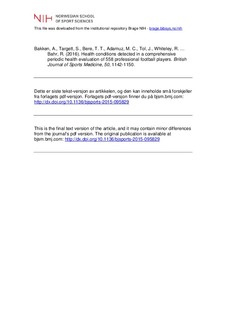| dc.contributor.author | Bakken, Arnhild | |
| dc.contributor.author | Targett, Stephen | |
| dc.contributor.author | Bere, Tone | |
| dc.contributor.author | Adamuz, Maria-Carmen | |
| dc.contributor.author | Tol, Johannes L. | |
| dc.contributor.author | Whiteley, Rod | |
| dc.contributor.author | Wilson, Mathew G. | |
| dc.contributor.author | Witvrouw, Erik | |
| dc.contributor.author | Khan, Karim M. | |
| dc.contributor.author | Bahr, Roald | |
| dc.date.accessioned | 2016-11-01T08:19:03Z | |
| dc.date.available | 2016-11-01T08:19:03Z | |
| dc.date.issued | 2016-03-24 | |
| dc.identifier.citation | British Journal of Sports Medicine. 2016, 50, 1142-1150 | nb_NO |
| dc.identifier.uri | http://hdl.handle.net/11250/2418462 | |
| dc.description | Dette er siste tekst-versjon av artikkelen, og den kan inneholde små forskjeller
fra forlagets pdf-versjon. Forlagets pdf-versjon finner du på bjsm.bmj.com /
This is the final text version of the article, and it may contain minor differences
from the journal's pdf version. The original publication is available at
bjsm.bmj.com | nb_NO |
| dc.description.abstract | Background: Despite widespread use of periodic health evaluation (PHE) to detect and
prevent injury and illness in athletes, its effectiveness in detecting health conditions and
relevant risk factors is still debated. Aim: To assess health conditions detected by a
comprehensive PHE in professional male football players and evaluate their consequences
for participation clearance. Methods: A total of 558 professional football players in Qatar
completed a PHE prior to the 2013 or 2014 seasons: history, general medical (including
blood test), cardiovascular (12-lead electrocardiogram (ECG) and echocardiography), and a
musculoskeletal examination, including a specific test battery targeting lower extremity
strength and flexibility. Based on the PHE, players were either cleared or not cleared for
participation. Results: In 533 players (95.5%), at least one health condition was detected
requiring treatment or follow-up. Vitamin D deficiency or insufficiency (≤ 30 ng/mL) was the
most common medical condition (n=499, 89.4%), followed by hepatitis B non-immunity or
infection (n=164, 29.4 %). Cardiac screening identified 48 players (8.6%) with one or more
abnormal findings [ECG (n=19, 3.4%) and echocardiography (n=14, 2.5%)]. Musculoskeletal
conditions were observed in 180 players (32.3%); injuries to or strength deficits of the
hip/groin and thigh accounted for the largest proportion. Medical clearance was temporarily
not given in 69 players (12.4%), whilst further examinations were being conducted. One
player was disqualified from competitive football. Conclusion: PHE revealed a high
prevalence of health conditions requiring treatment or follow-up in professional footballers;
however, only 12.4 % of conditions impacted on final clearance for participation. | nb_NO |
| dc.language.iso | eng | nb_NO |
| dc.publisher | BMJ | nb_NO |
| dc.subject | periodic health evaluation | nb_NO |
| dc.subject | screening | nb_NO |
| dc.subject | football | nb_NO |
| dc.subject | prevention | nb_NO |
| dc.subject | sport injuries | nb_NO |
| dc.subject | health protection | nb_NO |
| dc.title | Health conditions detected in a comprehensive periodic health evaluation of 558 | nb_NO |
| dc.type | Journal article | nb_NO |
| dc.type | Peer reviewed | nb_NO |
| dc.subject.nsi | VDP::Social science: 200::Social science in sports: 330::Other subjects within physical education: 339 | nb_NO |
| dc.source.journal | British Journal of Sports Medicine | nb_NO |
| dc.identifier.doi | 10.1136/bjsports-2015-095829 | |
| dc.description.localcode | Seksjon for idrettsmedisinske fag / Department of Sports Medicine | nb_NO |
